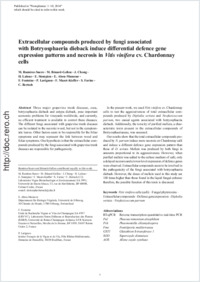Extracellular compounds produced by fungi associated with Botryosphaeria dieback induce differential defence gene expression patterns and necrosis in Vitis vinifera cv. Chardonnay cells
- Ramírez-Suero, M. Laboratoire Vigne Biotechnologie et Environnement, Université de Haute-Alsace, Colmar, France
- Bénard-Gellon, M. Laboratoire Vigne Biotechnologie et Environnement, Université de Haute-Alsace, Colmar, France
- Chong, J. Laboratoire Vigne Biotechnologie et Environnement, Université de Haute-Alsace, Colmar, France
- Laloue, H. Laboratoire Vigne Biotechnologie et Environnement, Université de Haute-Alsace, Colmar, France
- Stempien, E. Laboratoire Vigne Biotechnologie et Environnement, Université de Haute-Alsace, Colmar, France
- Abou-Mansour, Eliane Département De Biologie Végétale, Université de Fribourg, Switzerland
- Fontaine, F. Unité de Recherche Vignes et Vins de Champagne, Université de Reims Champagne Ardenne, France
- Larignon, Philippe Institut Français de la Vigne et du Vin, Rodilhan, France
- Mazet-Kieffer, F. Laboratoire Vigne Biotechnologie et Environnement, Université de Haute-Alsace, Colmar, France
- Farine, S. Laboratoire Vigne Biotechnologie et Environnement, Université de Haute-Alsace, Colmar, France
- Bertsch, C. Laboratoire Vigne Biotechnologie et Environnement, Université de Haute-Alsace, Colmar, France
-
22.04.2014
Published in:
- Protoplasma. - 2014, p. 1–10
English
Three major grapevine trunk diseases, esca, botryosphaeria dieback and eutypa dieback, pose important economic problems for vineyards worldwide, and currently, no efficient treatment is available to control these diseases. The different fungi associated with grapevine trunk diseases can be isolated in the necrotic wood, but not in the symptomatic leaves. Other factors seem to be responsible for the foliar symptoms and may represent the link between wood and foliar symptoms. One hypothesis is that the extracellular compounds produced by the fungi associated with grapevine trunk diseases are responsible for pathogenicity. In the present work, we used Vitis vinifera cv. Chardonnay cells to test the aggressiveness of total extracellular compounds produced by Diplodia seriata and Neofusicoccum parvum, two causal agents associated with botryosphaeria dieback. Additionally, the toxicity of purified mellein, a characteristic toxin present in the extracellular compounds of Botryosphaeriaceae, was assessed. Our results show that the total extracellular compounds produced by N. parvum induce more necrosis on Chardonnay calli and induce a different defence gene expression pattern than those of D. seriata. Mellein was produced by both fungi in amounts proportional to its aggressiveness. However, when purified mellein was added to the culture medium of calli, only a delayed necrosis and a lower-level expression of defence genes were observed. Extracellular compounds seem to be involved in the pathogenicity of the fungi associated with botryosphaeria dieback. However, the doses of mellein used in this study are 100 times higher than those found in the liquid fungal cultures: therefore, the possible function of this toxin is discussed.
- Faculty
- Faculté des sciences et de médecine
- Department
- Département de Biologie
- Language
-
- English
- Classification
- Biological sciences
- License
-
License undefined
- Identifiers
-
- RERO DOC 209874
- DOI 10.1007/s00709-014-0643-y
- Persistent URL
- https://folia.unifr.ch/unifr/documents/303515
Statistics
Document views: 173
File downloads:
- pdf: 408
